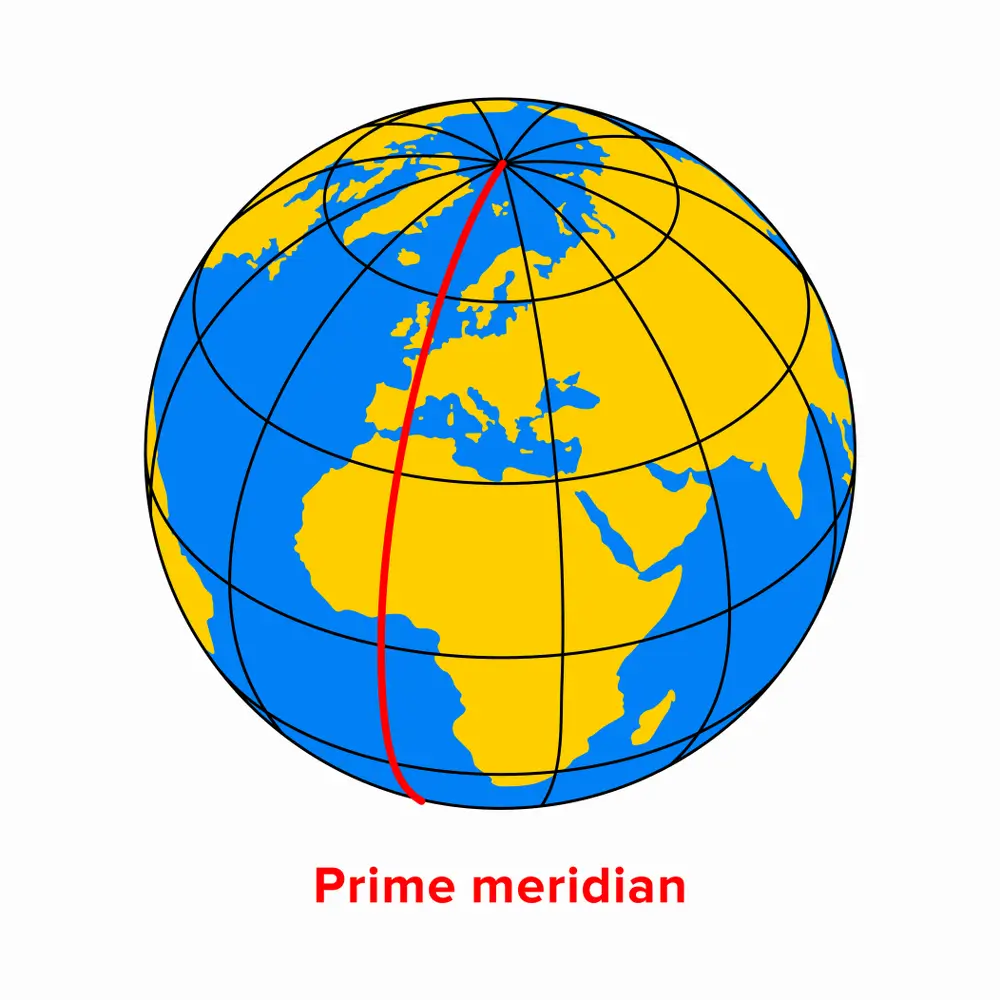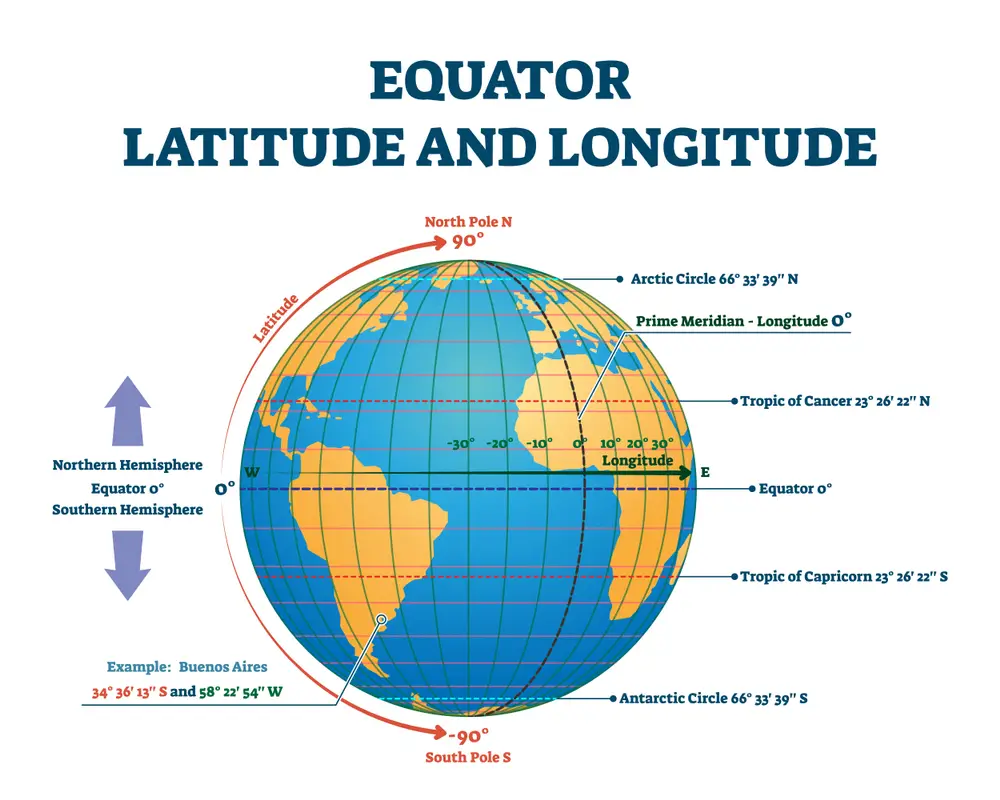Latitude and longitude work together to create a global grid known as a coordinate system. There are latitude and longitude values for every place. Everything on the earth’s surface is positioned using latitude and longitude. Either north or south of the equator is where you are, and either East or West of Latitude zero. Therefore, cartographers employ these dimensions to place any landmark on a map.
Only with the help of that site’s latitude and longitude can the precise location of any place on earth be determined.
The difference between longitude and latitude is that longitude is a measurement east or west of the prime meridian, whereas latitude is a measurement north or south of the equator.
Let’s first understand the basic definitions of latitude and longitude below:
Table of Contents
What is Latitude?

The invisible, horizontal lines that round the world are called latitudes. Latitude is a geographic coordinate indicating a point’s north-south location on the earth’s surface.
Latitudes can be used to study how the earth’s climate is generally divided.
Latitude can be used to better grasp a variety of geographic ideas. Latitude also assists us in understanding the pattern of wind circulation on the earth’s surface. Examples include the distribution of solar activity on the earth’s surface and the amount of rainfall.
As an example, the trade winds move from high subtropical latitudes to low tropical latitudes. With latitude, many geographical phenomena can be understood. It also helps in figuring out a country’s horizontal extent.
Latitudes are those imaginary, horizontal, circular lines parallel to one another on the planet. Latitudes are also known as parallels in this sense. Examples of latitudes are the equator, cancer, and Capricorn tropics.
What is Longitude?

The north and south poles are intersected by longitude lines, which are large circles worldwide. The difference in degrees between a location and the prime meridian, which passes through England at 0° degrees, is known as the longitude.
Longitudes are the primary factor in determining time, so they are crucial in determining the time of various locations around the world.
Longitudes and latitudes are crucial for creating accurate maps of different regions of the world and are the foundation of cartography. Longitudes facilitate the vertical extension of a geographic entity.
Longitudes are imaginary vertical lines. They don’t run parallel to one another. At the poles, they cross paths. As a result, the distance between two longitudes gets smaller from the equator to the poles. They are also referred to as meridians. Longitude is the prime meridian.
Positive and Negative Longitude
Negative longitude is west of the prime meridian, whereas positive longitude is east of the prime meridian (a north-south line that runs through a point in England).
Lines of Longitude and Latitude
The longitude lines are oriented north and south. They are used to specify a location’s East-West orientation on the earth. The equator and latitude lines are parallel to them.
First of all, both are imaginary lines that mankind created to help them locate and identify particular locations on earth. It is entirely a human invention.
An individual east-west point on the planet can be located using its longitude.
Functions of Longitude and Latitude
Similar to how every physical house has an address that comprises its address, which includes the number, the name of the street, the city, etc., latitude and longitude are two coordinates that combined allow you to determine exactly where you are on the planet.
Because latitude and longitude can be used to specify any point on the surface of the world, they are also known as geographic coordinates.
Since latitude and longitude are used to precisely determine a spot on the earth’s surface, we can specify almost any point on the planet.
Key West Latitude and Longitude
The Latitude of Key West is 24.555059, and the longitude is -81.779987.
Difference Between Longitude and Latitude

There are many differences between longitude and latitude given below:
- The primary difference between longitude and latitude is that latitude is the term used to describe the geographic coordinates that determine how far a site is from the equator on the north-south axis. On the other hand, longitude is the name for the geographic coordinate that indicates how far a site is from the Prime Meridian to the east and west.
- Another difference between longitude and latitude is that east to west is the direction of latitude, which is parallel to the equator. On the other hand, longitude runs from north to south, cutting across the two poles.
- 0° to 90° degrees is the range of latitudes, while 0° to 180° degrees is the range of longitudes.
- The references run parallel to one another in latitude. On the other hand, the lines of reference are not parallel to one another in longitude.
- Heat zones, such as the torrid, temperate, and freezing zones, are classified according to latitude. In contrast, time zones are categorized using longitudes.
- The meridians of longitude are equal in length although the parallels of latitude are not.
What are the Differences Between Longitude and Latitude?
Highlighting the main differences between longitude and latitude in the following table:
| Longitude | Latitude |
|---|---|
| Longitude refers to the geographic coordinate that indicates how far a site is from the Prime Meridian on the east and west sides. | Latitude denotes the geographic coordinate that establishes a point’s separation from the equator in terms of its north-south location. |
| The direction of longitude goes from north to south. | The direction of latitude goes from east to west. |
| Meridians, which are imaginary vertical lines that traverse the globe, are a part of longitude. | Meridians, which are fictitious horizontal lines that traverse the globe, are a part of latitude. |
| The lines of references are not parallel to one another in longitude. | The lines of references are parallel to one another in latitude. |
| There are 360 lines in longitude | There are 180 lines in latitude. |
Conclusion
Without using the mathematical method, it was challenging to pinpoint any place on the earth’s surface due to its size. Latitude and longitude are imaginary lines drawn on the globe for this purpose. Latitude and longitude are imaginary lines that are used to identify spots on the surface of the globe that are measured in degrees.
The difference between latitude and longitude is that longitude is a measurement east or west of the prime meridian, whereas latitude is a measurement north or south of the Equator.
Find more: What is the Difference Between Countries and Continents?


